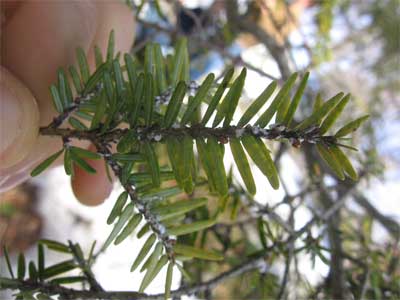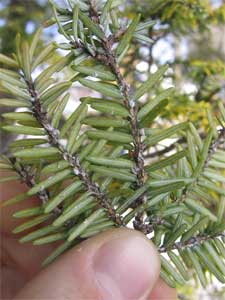and problematic species
The Hemlock Woolly Adelgid
The Hemlock Woolly Adelgid (Adelges tsugae; HWA) is an invasive insect species in the eastern United States. The adelgid is a native species of Japan, and is thought to have been introduced into North America in the 1920s. It is a pest of the eastern hemlock (Tsuga canadensis) and the Carolina hemlock (Tsuga caroliniana). Their name comes from the woolly appearance of egg clusters, which are laid on the underside of hemlock branches (see above pictures). The adelgid feed on hemlock needles, and heavily infested trees usually die within 2-12 years. HWA will infect hemlock trees of all ages. Left uninfected, hemlocks can live for 800 years, sometimes more. They can grow to a majestic height of 175 feet, with mature trunks sometimes growing to be over 6 feet wide. Because hemlock species are extremely shade-tolerant, they frequently cover the forest floor in places where other tree species could not survive. Hemlock usually root and develop in the shade of other dominant tree species, and then quickly grow when these larger trees die and more light becomes available. In this way, they can eventually dominate forest patches from the forest floor all the way to the canopy.


The Adelgid has been wreaking havoc on hemlocks for a variety of reasons. Like many other invasive species, it has no known natural predators in the US. The lack of predatory pressure allows HWA to proliferate without control. It is also a parthenogenetic species, meaning that every adult is capable of rapid asexual reproduction. Each adelgid typically lays about 100 eggs, with the potential to lay several hundred. This high level of fecundity makes the species more prone to spread rapidly and do serious damage to hemlock populations. It also provides a wide buffer; even if much of an adelgid population is wiped out, it will still have a high chance of recovery. HWA's life cycle has two generations per year. Eggs are initially laid in spring, on the bottom of the hemlock branches, about where the needles meet the branch (see above pictures). When they hatch, the immature insects feed at the base of the hemlock needles. By June, this generation is matured, and lays another slew of eggs. These new eggs hatch in July and migrate to a different hemlock stand, where they stay dormant until October. Then, they again feed on the hemlock, continuing throughout the winter until they reach maturity in the spring, and the cycle begins anew. HWA damage the trees by feeding on starch reserves, effectively reducing the tree's ability to grow new branches.
Natural predators of HWA exist in Japan and China, mostly beetles and fungi. One possibility for controlling HWA in the US is to import these predators to use as biocontrols. However, so far these efforts have had a minimal impact. In addition to biocontrols, investigations are underway to find effective chemical controls. Many spraying concoctions, mostly soaps and oils, have had promising success at controlling HWA, but there have been no effective methods found to implement them on a broad scale. Other proposed methods for control include selective logging, either by cutting down only trees that are currently infested, or preemptively cutting down large swaths of uninfected hemlock, in an effort to prevent future spread.

The Quabbin watershed is home to many groves of eastern hemlock. Data from the Department of Conservation and Recreation (DCR) and the Division of Water Supply Protection (DWSP) indicates that about ~3% of the watershed land under their control is pure hemlock stands, and another ~9% consists of stands of hemlock interlaced with other tree species. The DWSP controls about 58,000 acres of Quabbin land; 7,076 acres of land have significant amounts of hemlock.
Many researchers fear that the loss of significant areas of hemlock overstory would have significant negative impacts on water quality, due to increased stream temperatures, and increased levels of nitrification and nitrogen mineralization, increasing amounts of inorganic nitrogen in the water. Inorganic nitrogen is normally recaptured and immobilized by accumulation in the trees. Nitrification and nitrogen leaching have significant negative impacts on water quality, which is clearly of utmost concern for management of the Quabbin watershed forests. Because of these adverse effects, there is question as to whether selective logging plans to control HWA would have strong negative impacts on the Quabbin's water quality. In addition to nitrogen runoff, significant removal of any overstory trees, including hemlock, increases the amount of soil moisture and subsurface water flow in the area. For the Quabbin, this would increase the amount of organic matter and inorganic nutrients that are transported from the forest to the reservoir, which would most likely have negative impacts on the water quality. The main reason that the Quabbin Reservoir remains unfiltered is that its large forested watershed acts as an adequate filter. Removing large amounts of hemlock would create a situation where the reservoir's water quality may be in question. The DWSP has therefore stated that it will not preemptively cut patches of uninfected hemlock, and is very conservative about cutting other stands of hemlock, even if they are infected. And, although less relevant to management of the Quabbin watershed, heavy losses of hemlock will result in a loss of tree diversity and habitat loss for many woodland species. These losses not only decrease the aesthetic value of the forests, but threaten the biodiversity of the affected forests as well.

| © 2008 Jason, Jeff, Julian & Juliet | ↑ go to the top | Design by Nicolas Fafchamps |